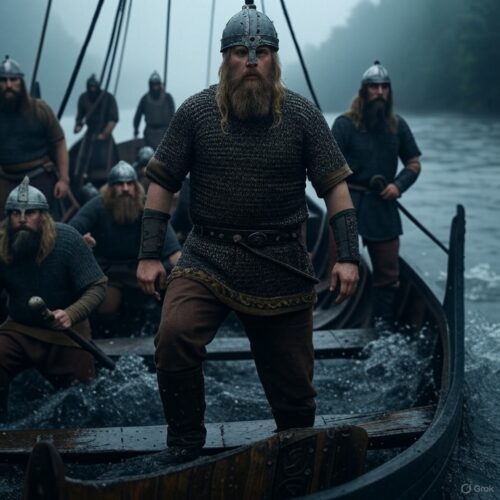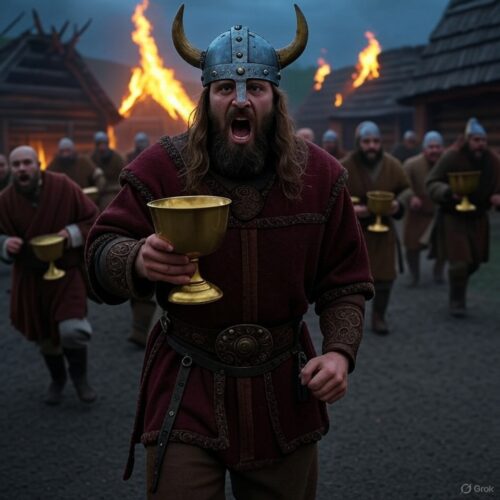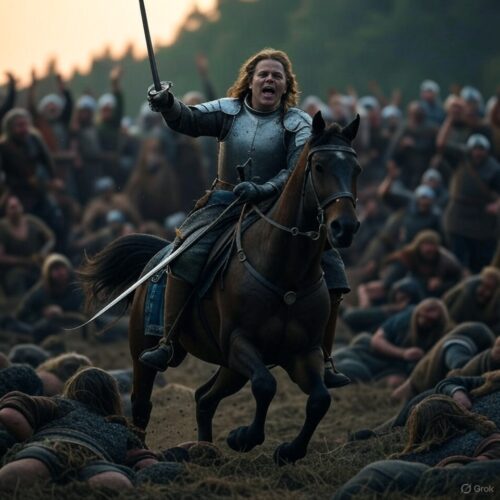Welcome to a journey back in time, where the clash of steel and the roar of waves meet the unyielding spirit of human resilience. On August 3, 881, in the rolling fields of Saucourt-en-Vimeu in northern France, a pivotal battle unfolded that pitted the young kings of West Francia against the fearsome Viking raiders. This wasn’t just any skirmish; it was a rare, decisive victory in an era dominated by Norse terror. We’ll dive deep into the historical depths of this event—exploring the Carolingian world, the Viking scourge, the battle’s gritty details, and its echoing aftermath—before bridging it to our modern lives with practical, motivational insights. Prepare for an informative ride filled with epic tales, poetic heroism, and lessons that could change how you face your own ‘raids’ today. Let’s set sail into history!
### The Carolingian Canvas: A Empire Fractured and Vulnerable
To understand the Battle of Saucourt-en-Vimeu, we must first paint the picture of the 9th-century Frankish world. The Carolingian Empire, forged by Charlemagne (Charles the Great) in the late 8th century, was a sprawling dominion that stretched from the Pyrenees to the Elbe River, encompassing much of Western Europe. Charlemagne, crowned Emperor by Pope Leo III in 800 AD, had united disparate tribes under a banner of Christian expansion, military might, and administrative reform. His court at Aachen was a hub of learning, where scholars revived classical knowledge, and his armies pushed back Muslim forces in Spain and pagan Saxons in Germany.
But empires built on conquest often crumble under succession. Charlemagne died in 814, leaving the throne to his son Louis the Pious. Louis’s reign was marred by internal strife, as he divided the empire among his sons—Lothair, Pepin, Louis the German, and Charles the Bald—in a tradition known as partible inheritance. This led to civil wars, culminating in the Treaty of Verdun in 843, which split the empire into three kingdoms: West Francia (roughly modern France, under Charles the Bald), Middle Francia (a strip from the Low Countries to Italy, under Lothair I), and East Francia (roughly modern Germany, under Louis the German).
By the mid-9th century, these divisions had weakened the Franks. Charles the Bald, king of West Francia from 843 to 877, faced constant threats. He dealt with rebellions from Aquitaine and Brittany, but the real storm came from the north: the Vikings. These Norse seafarers, from Denmark, Norway, and Sweden, were driven by overpopulation, political instability, and a thirst for wealth. Their longships, sleek vessels with shallow drafts, allowed them to navigate rivers and strike inland with lightning speed. Viking raids began in earnest around 793 with the sack of Lindisfarne monastery in England, but by the 830s, they turned their eyes to Francia.
Charles the Bald responded with fortifications, such as bridges and watchtowers along the Seine, and the Edict of Pistres in 864, which mandated mounted warriors and fortified bridges to counter raids. Yet, the Vikings persisted. In 845, a fleet led by the legendary Ragnar Lothbrok besieged Paris, forcing Charles to pay 7,000 pounds of silver in danegeld (tribute) to leave. Raids continued, with Vikings overwintering in Francia for the first time in 852, establishing bases like the one on the island of Oissel near Rouen.
Charles died in 877, succeeded by his son Louis the Stammerer, who ruled only until 879. Louis’s death left his teenage sons, Louis III (about 16 years old) and Carloman II (about 13), to share the kingdom. Louis III took the northern territories, including Neustria and Francia proper, while Carloman handled the south. These young kings inherited a realm plagued by Viking incursions. The Norsemen, often called Danes in contemporary sources, exploited the power vacuum, raiding monasteries for gold, slaves, and food.

### The Viking Storm Builds: Raids Leading to Saucourt
The late 870s and early 880s saw a surge in Viking activity across Europe. In England, the Great Heathen Army, led by figures like Ivar the Boneless, conquered much of the Anglo-Saxon kingdoms, establishing the Danelaw. In Francia, the Vikings shifted from hit-and-run tactics to more sustained campaigns. After a defeat at the Battle of Thimeon in 880 by Louis the Younger of East Francia, a large Viking force turned westward.
In November 880, they captured Kortrijk (Courtrai) in Flanders, using it as a base to ravage the surrounding areas. By December, they struck Arras and Cambrai, burning churches and enslaving locals. The Annals of Saint-Vaast, a contemporary chronicle, describe the terror: “The Northmen… devastated everything with fire and sword.” In early 881, the Vikings pushed deeper into Picardy, sacking the wealthy abbeys of Amiens and Corbie. Amiens, a key trade center, was looted of its treasures, while Corbie’s scriptorium, famous for its illuminated manuscripts, was torched.
These raids weren’t just plundering; they were strategic. Vikings targeted monasteries because they were undefended repositories of wealth, accumulated through donations and tithes. The Norsemen, pagan at this time (though some converted later), showed no mercy to Christian sites, viewing them as easy prey. Their tactics involved surprise attacks, using rivers like the Somme and Seine for rapid movement. Warriors fought with axes, swords, and round shields, often in a shield-wall formation, and their berserkers—warriors in a trance-like fury—struck fear into Frankish hearts.
Louis III and Carloman II, despite their youth, rallied. Louis III, described in sources as brave and energetic, gathered forces in the north. The brothers united their armies, drawing on mounted knights (the precursors to medieval chivalry) and infantry levies. The Franks, inheriting Roman and Germanic traditions, fought with spears, swords, and some cavalry, though not as heavily armored as later knights.
As summer 881 approached, the Vikings, laden with loot, camped near Saucourt-en-Vimeu, a small village in the Vimeu region of Picardy, about 20 miles northwest of Amiens. The site was strategic, near the coast for escape and amid fertile lands for provisioning. The Frankish scouts spotted them, and Louis decided to strike.

### The Battle Unfolds: Steel, Song, and Slaughter
On August 3, 881, under a likely overcast sky typical of northern France, the Battle of Saucourt-en-Vimeu commenced. Details are sparse—chronicles like the Annals of Fulda and Annals of Saint-Bertin provide brief accounts—but the event is immortalized in the Ludwigslied, an Old High German poem composed shortly after, possibly within months.
The poem, 59 rhyming couplets long, portrays Louis III (Hluduig in the text) as a divinely favored king. It begins: “I know a king—his name is Hluduig—who serves God zealously: I know He rewards him for it.” It recounts Louis’s orphanhood (his father died young), God’s guardianship, and the sharing of the kingdom with Carloman.
The narrative builds tension: God tests the Franks with Viking raids as punishment for sins. The people repent, but chaos reigns until Louis returns. He raises his banner, councils with his men, and promises rewards: “Follow me boldly, and I shall reward you richly.” Discovering the enemy, Louis sings a “Christian battle-song” (perhaps a hymn or chant), charges, and wins through bravery.
Though poetic, this suggests the battle’s flow. The Vikings, estimated at several thousand, formed a defensive line, perhaps on a hill for advantage. The Franks, numbering similarly or slightly more, attacked in waves. Louis and Carloman led personally, inspiring troops with speeches. The clash was brutal—axes cleaving shields, spears thrusting, horses trampling. The Annals of Fulda report 9,000 Vikings slain, a staggering number indicating a rout.
Tactics likely involved Frankish cavalry charges breaking Viking lines, followed by infantry mopping up. Vikings excelled in raids but struggled in pitched battles against organized forces. The Franks’ victory stemmed from unity, local knowledge, and perhaps surprise. The poem attributes it to divine favor, reflecting the era’s Christian worldview.
As the sun set, the field was littered with bodies. Viking survivors fled to ships or hid in woods. The Franks captured loot, boosting morale. Louis was hailed as a hero, his name echoing in songs.

### Aftermath and Legacy: A Fleeting Glory
The victory at Saucourt was celebrated, but short-lived. Louis III couldn’t pursue the Vikings due to logistical issues and internal politics. Raids shifted east to Lotharingia (Middle Francia), where in 882, Charles the Fat besieged a Viking camp at Asselt, negotiating peace rather than fighting.
Tragedy struck soon: On August 5, 882—almost exactly a year after Saucourt—Louis III died in a bizarre accident. Chasing a girl on horseback in Saint-Denis, he hit his head on a low door lintel, fracturing his skull. He was 18 or 19. Carloman II became sole king but died in a hunting accident in 884, aged 18. West Francia passed to Charles the Fat, uniting the Carolingian realms briefly before his deposition in 887.
The battle’s legacy endures in the Ludwigslied, the only surviving Old High German heroic lay. Preserved in a 9th-century manuscript from Saint-Amand abbey (destroyed by Vikings in 883), it blends Germanic epic tradition with Christian piety. The poem’s Rhine Franconian dialect hints at composition near the Romance-Germanic border, perhaps by a monk or court poet.
Historically, Saucourt highlights the Carolingian decline. Viking raids continued until the 10th century, leading to the Duchy of Normandy in 911 when Rollo was granted lands. Yet, it showed Franks could win if united. It influenced later defenses, like Odo of Paris’s stand in 885-886, saving the city and earning kingship.
Culturally, it fed the Viking mythos—feared warriors defeated by underdogs. In modern Picardy, Saucourt is remembered in local lore, with the battlefield now peaceful farmland.

### Bridging Centuries: Lessons from Saucourt for Your Life Today
Now, let’s turn this ancient triumph into fuel for your modern battles. The outcome of Saucourt—a hard-won victory against overwhelming odds, celebrated yet fleeting—teaches us about resilience, preparation, and capitalizing on wins. The Vikings represent chaos: unexpected challenges that invade our lives, like job loss, health crises, or relationship strains. The Franks’ success came from unity, faith, and bold action. By applying this, you can transform personal setbacks into stepping stones. Here’s how this historical fact benefits you today, with specific applications to your individual life.
– **Identify Your Personal ‘Vikings’**: Just as the Franks faced Norse raiders, pinpoint the disruptive forces in your life. For example, if procrastination is raiding your productivity, recognize it as an invader stealing your time and energy.
– **Build Your Defensive Fortifications**: Emulate Charles the Bald’s edicts by creating barriers against challenges. If financial instability is your Viking, set up an emergency fund starting with $50 weekly deposits into a high-yield savings account.
– **Rally Your Allies Like the Brother Kings**: Louis and Carloman united; do the same by forming a support network. If facing career burnout, schedule monthly meetups with mentors or friends to brainstorm solutions and share encouragement.
– **Sing Your Battle Song for Motivation**: The Ludwigslied’s Christian chant inspired troops—craft your own affirmations. Before a big presentation, repeat: “I am bold like Louis, rewarded for my zeal,” to boost confidence and focus.
– **Strike Decisively in Pitched Battles**: Don’t let opportunities slip like post-Saucourt. If overcoming addiction, commit to a daily routine: wake at 6 AM for exercise, journal triggers, and attend support groups thrice weekly.
– **Celebrate Wins to Build Momentum**: The Franks rejoiced; after achieving a goal, like losing 10 pounds, reward yourself with a new book or outing, reinforcing positive habits.
– **Learn from Fleeting Victories**: Louis’s death reminds us life is unpredictable—secure gains immediately. After a promotion, update your resume and network within a week to prepare for future shifts.
– **Embrace Faith or Purpose as Your Guardian**: The poem’s divine theme suggests grounding in belief. If spiritual, pray daily; if not, define a personal mission statement to guide decisions during tough times.
To make this actionable, here’s a 7-day plan inspired by Saucourt to apply this historical victory to your life:
- **Day 1: Scout the Enemy** – Spend 30 minutes journaling your top three challenges. Detail how they ‘raid’ your peace, like Vikings sacking abbeys.
- **Day 2: Fortify Your Realm** – Create one barrier per challenge. For stress, download a meditation app and commit to 10 minutes daily.
- **Day 3: Assemble Your Army** – Reach out to two people for support. Text a friend: “Hey, facing [issue], can we chat strategies?”
- **Day 4: Compose Your Song** – Write three affirmations based on the Ludwigslied. Recite them morning and night.
- **Day 5: Launch the Attack** – Take one bold action. If job-hunting, apply to five positions with tailored cover letters.
- **Day 6: Claim Victory and Reflect** – Achieve a small win, then note what worked. Celebrate with a favorite treat.
- **Day 7: Secure the Aftermath** – Plan for sustainability. Set reminders for ongoing habits and review progress weekly.

Imagine channeling Louis’s zeal—turning fear into ferocity, doubt into determination. This isn’t just history; it’s a blueprint for invincibility. Rise like the Franks at Saucourt, and watch your life transform!

